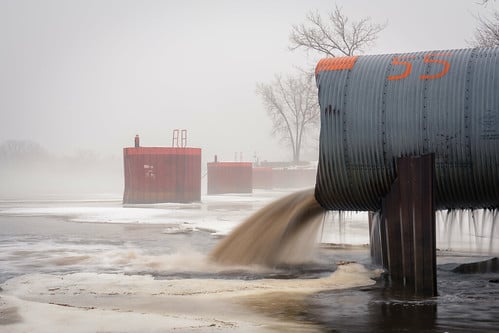For nearly 30 years, environmental regulation has included examples of market-like mechanisms, where overall pollution limits (“budgets”) are set and individual sources assigned trade-able “emission credits” that can be traded among sources as they negotiate the most efficient pathways to overall reduction necessary to meet the budget. Although proliferating “cap and trade” systems for greenhouse gases are probably the most widely known, other examples abound.
Read MoreAudit, Compliance and Risk Blog
Tags: Environmental risks, Environmental, EPA, clean water
EPA Proposes to Revise Rule Governing Lead in Drinking Water
Posted by Jon Elliott on Tue, Dec 10, 2019
Since 1991, Safe Drinking Water Act’s (SDWA) Lead and Copper Rule (LCR) has required public water systems (PWSs) to take steps to protect their customers from hazardous levels of lead in drinking water. Even before the highly-publicized crisis in Flint, Michigan, the Environmental Protection Agency (EPA) was working to update and expand LCR’s protective measures. These efforts include a 2016 White Paper announcing the “urgent need” for revisions, describing key issues and possible revisions, and projecting a proposal to issue extensive LCR revisions during 2017. However, after President Trump assumed office, EPA’s priorities shifted and the agency delayed action (I summarized the existing LCR and wrote about EPA’s regulatory delay here). In November 2019, EPA proposed LCR changes, which I summarize below.
Read MoreTags: Environmental risks, Environmental, EPA, clean water
Since assuming office, President Trump and his administration have generally sought to reduce and repeal formal federal regulations, and to tighten appointed agency heads’ direct control over their agencies’ regulatory actions. These efforts have included executive orders (EO) from the President providing government-wide mandates and priorities (For example, I wrote about EO 13777, “Reducing Regulation and Controlling Regulatory Costs”, here). They have also included formal regulatory proceedings, mostly directed toward reducing or revoking requirements adopted during President Obama’s tenure (for example, I wrote about the latest changes to national vehicle emission standards here). Individual agencies have followed and reinforced these efforts (For example, I wrote about the Environmental Protection Agency “Back to Basics” initiative here).
Read MoreTags: Business & Legal, Audit Standards, Environmental, EHS
In May 2017, the Environmental Protection Agency (EPA) convened a task force of career professionals to evaluate the agency’s Superfund cleanup policies and make recommendations for improvements. The Task Force issued recommendations in December 2017 (I wrote about them here), and has now issued its final report. The report includes multiple examples of accomplishments related to each of the Task Force’s five goals.
Read MoreTags: Environmental risks, Environmental, EPA, site auditing
Feds Issue Nationwide Motor Vehicle Greenhouse Gas Standards and Declare California’s Standards to be Preempted
Posted by Jon Elliott on Tue, Oct 22, 2019
The federal government has taken another step in its car wars with California. Late in September the Environmental Protection Agency (EPA) and the National Highway Traffic Safety Administration (NHTSA) issued joint rules declaring NHTSA’s preemptive authority to set national standards covering greenhouse gas (GHG) emissions from petroleum-fueled vehicles and electric vehicles, and revoking a waiver from EPA that lets California set such standards.
Read MoreTags: California Legislation, Environmental risks, Environmental, EPA, ghg, Transportation, greenhouse
Department of Justice Reemphasizes its Disfavor for Supplemental Environmental Project Agreements with State and Local Governments
Posted by Jon Elliott on Tue, Oct 15, 2019
Since President Trump took office, the US Department of Justice (DOJ) has taken repeated steps to restrict federal attorneys from negotiating settlements in which defendants agree to conduct “supplemental environmental projects (SEPs)” in exchange for reduced formal penalties for the noncompliance that led to the agency investigation and enforcement. Proponents see SEPs as a way to promote environmental and health values by encouraging defendants to undertake projects that wouldn’t occur otherwise in order to reduce or eliminate civil and/or criminal liability. Opponents see them as rogue efforts in which prosecutors substitute their own judgment for the statutory and regulatory directives that are supposed to guide their actions.
Read MoreTags: Business & Legal, Environmental risks, Environmental, EHS, EPA, clean water
Chemical Safety Board To Work on Accident Reporting Regulations
Posted by Jon Elliott on Tue, Oct 01, 2019
Among nearly one thousand pages of expansions to Clean Air Act (CAA) requirements, the 1990 CAA Amendments legislation provided for the creation of a national agency to conduct independent investigations of major chemical accidents, to issue accident-specific findings and specific or general recommendations for improved chemical handling and regulation, and to establish chemical accident reporting regulations. This agency’s formal name is the Chemical Safety and Hazard Investigation Board – which usually refers to itself as the Chemical Safety Board or CSB. CSB was finally funded and began work in federal Fiscal Year (FY) 1997-1998.
Read MoreTags: Health & Safety, Environmental risks, Environmental, Hazcom, CAA, CSB
EPA Decides Not to Require SPCCs to Address Hazardous Substance Spills
Posted by Jon Elliott on Tue, Sep 24, 2019
The Clean Water Act (CWA) requires the Environmental Protection Agency (EPA) to define “oil” and “hazardous substances”, and includes requirements that EPA establish “procedures, methods, and equipment and other requirements for equipment to prevent discharges of oil and hazardous substances from vessels and from onshore facilities and offshore facilities, and to contain such discharges….” (33 USC § 1321(j)(1)(C)) Since 1973, EPA has required owners and operators of non-transportation-related onshore and offshore facilities to establish and implement Spill Prevention, Countermeasure and Control (SPCC) Plans if they manage more than threshold levels of oils (I summarized these requirements here).
Read MoreTags: Environmental risks, Environmental, EHS, EPA, Hazcom, effluent, Stormwater, clean water, spcc
DC Circuit Upholds Most of EPA’s 2015 Standards For Ground Level Ozone
Posted by Jon Elliott on Tue, Sep 17, 2019
On August 23, the federal Court of Appeals for the District of Columbia (DC Circuit) upheld most aspects of the National Ambient Air Quality Standards (NAAQS) for ground level ozone adopted by the Environmental Protection Agency (EPA) in 2015. The Clean Air Act (CAA) requires EPA to create a list of air pollutants based on emissions that cause or contribute to air pollution that may reasonably be anticipated to endanger public health or welfare (criteria pollutants), to establish NAAQS based on these criteria, and to review the NAAQS every 5 years.
Read MoreTags: Business & Legal, Health & Safety, Environmental risks, Environmental, EPA, Greenhouse Gas, ghg, CAA
EPA Proposes to Allow Hazardous Air Pollutant Sources to Reclassify From “Major” to “Area” Using Administrative Controls
Posted by Jon Elliott on Tue, Sep 10, 2019
The Clean Air Act (CAA) directs the Environmental Protection Agency (EPA) to define “hazardous air pollutants (HAPs)” that may pose acute health hazards, and to impose regulations to reduce those hazards. EPA requires permits for “major sources” of HAPs based on “Maximum Achievable Control Technologies (MACT),” and lesser controls for non-major “area sources.” Since the Trump Administration took office, EPA has pursued several initiatives to make it easier for sources to reclassify from “major” to “area” in order to reduce their regulatory responsibilities. For example, in January 2018 EPA ended a decades-old policy declaring that every emission source that met major source criteria at the time a MACT became effective was “once in, always in” and could not requalify as a less-regulated area source by accepting legally binding controls that reduce its “potential to emit (PTE).” (I wrote about this change here).
Read MoreTags: Health & Safety, Environmental risks, Environmental, EPA, Greenhouse Gas, ghg, Hazcom, Oil & Gas










